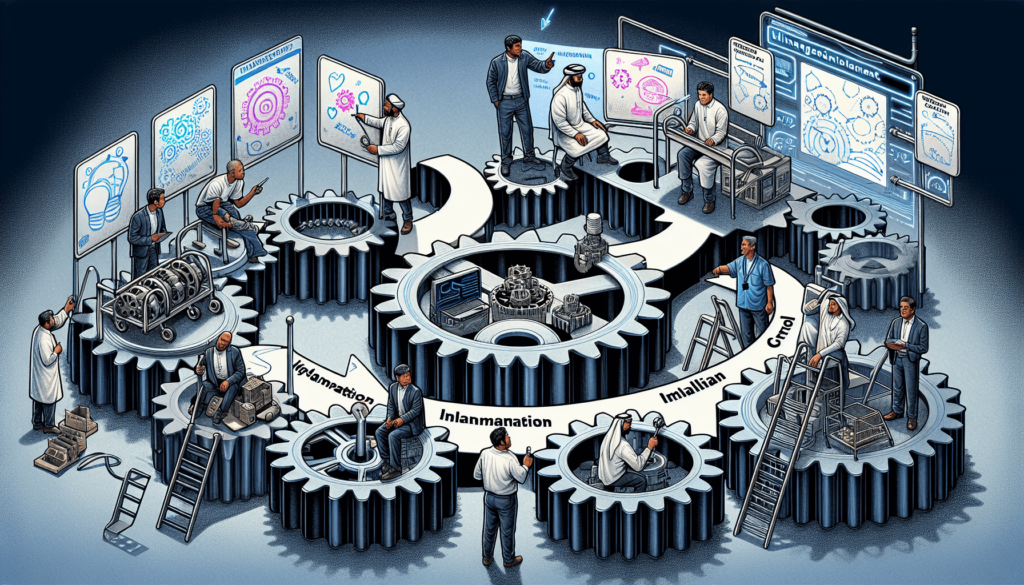What is change management: an effective strategy for change and success in companies
Change management - the systematic management of change in companies - is crucial for success and future viability. This article sheds light on what change management is, how you implement change management, why it is important and what concrete steps are necessary to adapt an organization to the fast-moving changes in the market.
The most important facts at a glance
- Change management is crucial for the adaptability and competitiveness of companies in the context of dynamic market conditions and technological developments.
- A successful change management process follows established models and phases, involves careful planning and communication and relies on the continuous involvement and training of employees.
- Change management success is measured and evaluated through continuous performance measurement based on KPIs and regular feedback in order to continuously optimize change processes and anchor them in the corporate culture.
Change management basics

Change management, also known as change management, is a business process that focuses on the management of change - not the execution of substantive tasks. In a dynamic business environment, companies need to be able to adapt to change in order to maintain their competitiveness. This could be in response to changing market conditions, internal changes or technological advances. Change management processes play a crucial role here.
However, implementing change management is not easy. Organizations tend to have a certain degree of inertia, and both employees and managers can have uncertainties and fears. Resistance to change is widespread and can have a significant impact on the success of change projects.
Definition of change management
Change management refers to the targeted realization of changes in:
- Organizational structures
- Processes
- Strategies
- Systems
- Behavioral patterns
The main objective of change management is to bring about a more or less far-reaching change in the organization.
An important aspect of change management is managing the human aspect. It is about reducing resistance and increasing the likelihood of successful change.
The relevance of change management for modern organizations
Change management contributes significantly to the competitiveness and agility of organizations by managing change and increasing adaptability. It is also crucial for managing dependency on IT systems and technology, as it evaluates and integrates changes in the IT environment.
It also makes it easier for organizations to adapt to changes and implement them successfully.
The change management process

Change management follows a step-by-step process that leads the organization from a current state through a transitional state to the desired future state. This process includes:
- the planning of goals
- the development of procedures
- the definition of time frames
- budgeting
- the planning of communication and training.
The implementation of change requires:
- Careful coordination through change management
- Execution by technical teams
- Risk assessments
- Tests before implementation
- The development of back-out plans
These measures are crucial to ensuring service quality when implementing changes.
Phases of change management

In change management, there are various models for describing the change process, each of which comprises specific phases. Kurt Lewin's 3-phase model, for example, describes the steps of 'unfreezing', 'changing' and 'freezing'. The ADKAR model comprises the phases 'Awareness', 'Desire', 'Knowledge', 'Ability' and 'Reinforcement'.
John P. Kotter developed an 8-step model that offers a holistic approach for the successful implementation of change in organizations.
Methods and tools
In change management, it is crucial that standardized methods and procedures are available and used efficiently to manage change. Risks in change management are identified using methods such as risk assessments, brainstorming and stakeholder interviews and analyzed and prioritized using tools such as risk matrices, risk registers and risk maps.
A treatment strategy is developed and continuously monitored for each identified risk in order to check the effectiveness of these strategies and identify new risks.
- Do you know my SEO newsletter?
Register now and receive regular tips from the experts.
The role of the change manager

A change manager is responsible for shaping change processes in an organization. Their task is to
- improve the status quo
- increase the competitiveness of the company
- carry out the planning, implementation and control of change processes
- Analyzing the opportunities and risks of change
- carry out the development of implementation strategies.
A change manager is also responsible for the following tasks:
- Communication of results
- Monitoring the implementation of change plans
- Advice and contact person for questions regarding company changes
- Responsibility for changing the knowledge, attitude and behavior of team members.
Specialist knowledge and skills
A degree in business administration or comparable training, combined with relevant professional experience, forms the foundation for the role of a change manager. The professional skills of a change manager include analytical thinking and project management skills. Personal skills such as strong communication skills and empathy are essential.
Persuasiveness, flexibility and resilience round off the profile of a change manager.
Support from the change manager
Managers play a crucial role in integrating change management into the corporate culture, as their support is essential for the use of new procedures. Change managers serve as advisors and contacts for questions about corporate change and are responsible for changing the knowledge, attitudes and behavior of team members.
Challenges in change management

The introduction of comprehensive, cross-functional change management processes, also known as change processes, can be perceived as additional bureaucracy that could hinder employees responsible for keeping IT operations running.
However, it is important to emphasize that change management is not only a challenge, but also an opportunity. Through proper planning and execution, change management can help to increase efficiency, make better business decisions and improve the overall performance of the organization.
Dealing with risks and resistance
Risk management in change management helps to overcome uncertainties, complexity and potential threats. Resistance to change is often caused by:
- Fears of loss of status
- Conflicts
- lack of success
- Habit
- Overload
These resistances can be significantly reduced through a deeper understanding of these factors.
The reasons for the failure of change projects can be overcome through active management and understanding of the underlying causes.
Change management in different types of organizations
Understanding how change will affect members of an organization at different levels and within different teams is critical to the change management process. Organizations need to comprehensively assess their technology maturity level to clearly understand the current state as well as the desired changes and successfully adapt change management to their specific needs.
Successfully designing change projects
The formulation of objectives in change projects must be specific, measurable, achievable and clear in order to facilitate the work of the project team. Project management tools are important for systematically analyzing problems, overcoming challenges in change projects and adapting and improving the process. Adequate timing is crucial for the implementation of change.
In order to consolidate changes in the corporate culture, organizations should achieve short-term successes and use these to motivate further changes and consolidate the transformation. Only in this way can a change project achieve its full effectiveness.
Objectives and planning
Planning in change projects requires:
- Realistic objectives
- a long-term perspective
- setting priorities
- the formulation of clear goals that follow the SMART criteria
These points are central to the success of a planned change.
In addition, it is important to create a thorough problem description that includes all parties involved.
Integration and communication
Employees should be involved in the change process, as they are directly affected by the impact and must support the change. Transparent and appreciative communication promotes the understanding and commitment of employees and is therefore crucial for the acceptance of change.
It is also important to design the change processes in such a way that they are tailored to the needs of the most important stakeholders in order to maximize the chances of success.
Measuring the success of change management
Performance measurement in change management should be continuous in order to be able to respond to problems at an early stage and not only have to react after the implementation has been completed. The long-term stability of changes can be measured by monitoring the number of support requests after the changeover, for example. Metrics can also be used to measure employee readiness, commitment and communication effectiveness.
Feedback plays a crucial role in change management in order to continuously optimize processes. Feedback allows those responsible to assess the extent to which the change management measures are achieving the desired goals. Feedback is used to recognize when adjustments or corrective measures are necessary in change management.
Key Performance Indicators (KPIs)
Quantitative and qualitative aspects need to be considered in successful change management projects and include numbers and metrics as well as user experience. Organizational performance, individual performance and the effectiveness of change management activities are the three main categories in which change management performance is measured.
The KPIs in change management include assessments of employee readiness, engagement measurements and the effectiveness of communication.
Feedback and continuous improvement
Feedback is a crucial aspect of change management in order to continuously optimize processes. Feedback allows those responsible to assess the extent to which the change management measures are achieving the desired goals.
Feedback is used to recognize when adjustments or corrective measures in change management are necessary.
Integration of change management into the corporate culture
Cultural analysis is an essential step in integrating change management into the corporate culture. It includes the identification of elements that may hinder change in the company.
Companies must constantly adapt to the rapidly changing markets brought about by digitalization in order to remain competitive. A change project only achieves its full effectiveness when it is firmly anchored in the corporate culture. The role of HR managers as change managers is becoming increasingly important due to the constantly evolving market conditions.
Long-term orientation
Companies must constantly adapt to the rapidly changing markets brought about by digitalization in order to remain competitive. A change project only achieves its full effectiveness when it is firmly anchored in the corporate culture.
The role of HR managers as change managers is becoming increasingly important due to the constantly evolving market conditions.
Promoting a culture of change
Adapting to change is often made more difficult by the existing corporate culture, which needs time to get used to new processes. The development of new organizational forms and the use of the advantages of project-based work support the development of a culture of change.
An intensive examination of content and a constructive and critical exchange between those involved are essential for promoting a culture of change.
-
Free
SEO strategy meeting
In a free SEO strategy talk, we uncover untapped potential and develop a strategy to help you become more successful on Google.

- More organic visibility
- More organic visitors to your website
- More inquiries & sales
Summary
In summary, change management is an indispensable part of modern business life. Through a systematic approach, organizations can respond to and manage change. The role of the change manager plays a crucial part in this. With the right planning, implementation and monitoring, change management can help to increase efficiency, make better business decisions and improve the overall performance of the organization.






